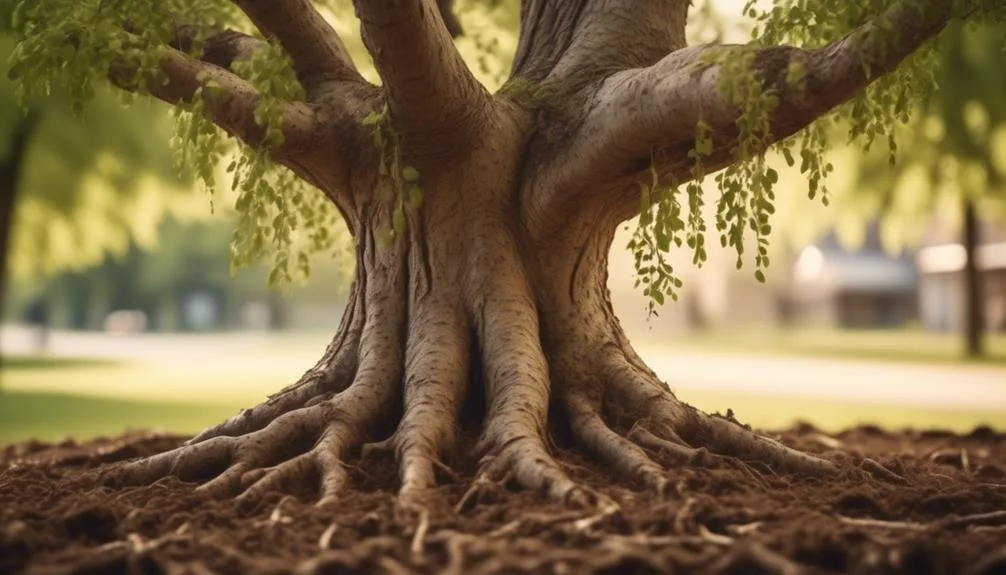Elm trees and their persistent suckers can be a puzzling sight. It's natural to wonder why these trees are so determined to spread their shoots everywhere. Understanding the reasons behind this behavior is crucial for maintaining the health and appearance of these impressive trees.
Let's explore the mystery of why elm trees produce suckers and the impact it has on their surroundings.
Elm Trees and Suckers
If you notice elm tree suckers sprouting up around the base of your tree, it's important to understand how to manage them effectively to maintain the health and vitality of your elm tree.
Elm trees are known for their extensive root systems, which can lead to the propagation of suckers. To manage these suckers, pruning techniques can be employed to remove them at the base without causing damage to the main tree.
Additionally, grafting can be used to redirect the energy of the suckers into more desirable growth. Understanding the root systems of elm trees is crucial in managing suckers, as it allows for targeted pruning and grafting to control their spread and promote the overall health of the tree.
Causes of Sucker Growth
Sucker growth on elm trees is often triggered by stress factors such as injury, disease, or inadequate pruning. When the root system of an elm tree experiences any form of damage, it can respond by producing suckers as a survival mechanism.
Additionally, environmental factors like water stress, extreme temperatures, or nutrient deficiencies can also contribute to sucker growth.
Inadequate pruning, especially when trees are pruned too severely, can stimulate the growth of suckers as the tree tries to compensate for the lost foliage.
Furthermore, elm trees are known for their ability to propagate through suckers, especially in response to unfavorable conditions.
Understanding these causes of sucker growth can help you take proactive measures to maintain the health and appearance of your elm trees.
Impact on Elm Tree Health
When suckers proliferate on elm trees, they can have a significant impact on the overall health and vitality of the tree. These shoots compete with the main tree for essential nutrients, water, and sunlight, leading to weakened growth and increased susceptibility to diseases and pests.
In severe cases, excessive sucker growth can hinder the tree's ability to produce new leaves and buds, ultimately compromising its ability to photosynthesize and store energy. This can result in stunted growth, sparse foliage, and overall decline in the tree's health.
To mitigate these effects and promote the health of elm trees, proper management is crucial. Regular pruning to remove suckers, along with maintaining optimal growing conditions and implementing preventive measures, can help minimize the negative impact on the tree's health.
How to Manage Elm Suckers
To effectively manage elm suckers and safeguard the tree's health, it's essential to implement proactive measures for controlling their growth and impact.
Utilizing proper pruning techniques is crucial in managing suckers. Regularly inspect the tree and promptly remove any suckers that emerge from the base or roots. This helps prevent the diverting of essential nutrients from the main tree.
Additionally, installing root barriers can be highly effective in controlling the spread of suckers. These barriers help restrict the growth of the tree's roots, subsequently reducing the formation of suckers. When choosing a root barrier, ensure it's installed at an adequate depth to prevent the suckers from emerging beyond the designated area.
Preventing Sucker Growth
If you want to prevent the growth of suckers around your elm tree, implementing proactive measures can be highly effective. Here are some techniques to help you prevent sucker growth:
- Pruning Techniques: Regularly prune your elm tree to remove any suckers that have already developed. Additionally, be sure to remove any branches that are rubbing against each other, as this can stimulate sucker growth.
- Root Barrier Installation: Consider installing a root barrier around the base of your elm tree to prevent suckers from sprouting. These barriers can help restrict the spread of roots and minimize the occurrence of suckers.
- Proper Maintenance: Ensure that your elm tree receives adequate water, nutrients, and sunlight to maintain its overall health and minimize the likelihood of sucker growth.
Conclusion
In managing and preventing the growth of elm tree suckers, we can ensure the tree's health and appearance. With care and attention, we can maintain a thriving elm tree in our yard, despite the natural response to stress or damage.
How we tend to our trees reflects our commitment to their well-being and the beauty they bring to our surroundings.

My interest in trees started when I first saw the giant sequoias in Yosemite.
I was a teenager then, and I remember thinking, “I need to learn more about this.”
That moment stuck with me.
A few years later, I went on to study forestry at Michigan Tech.
Since graduating, I’ve worked in a mix of hands-on tree care and community education.
I’ve spent over ten years helping people understand how to plant, maintain, and protect the trees in their neighborhoods.
I don’t see trees as just part of the landscape.
They are living things that make a real difference in our daily lives.
